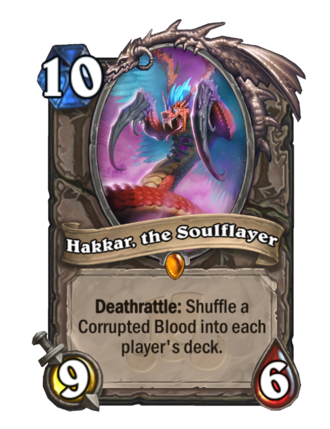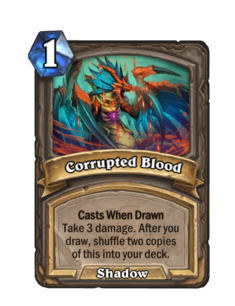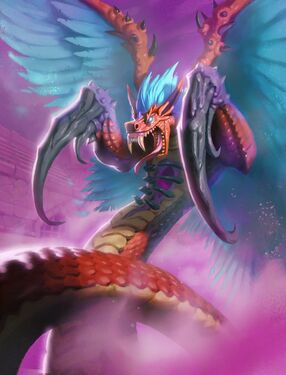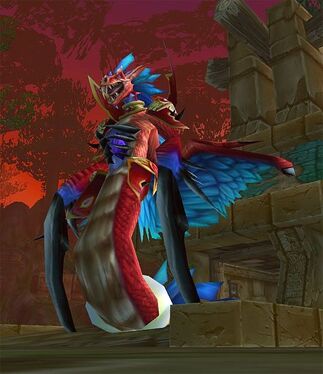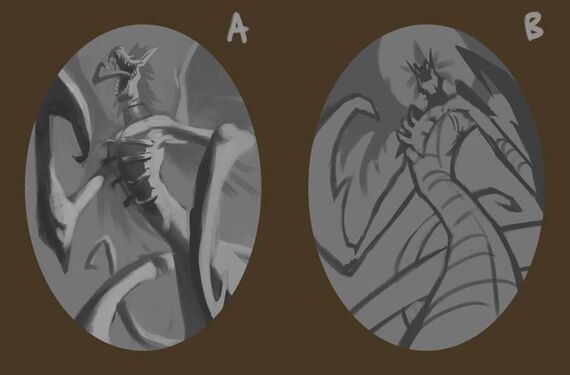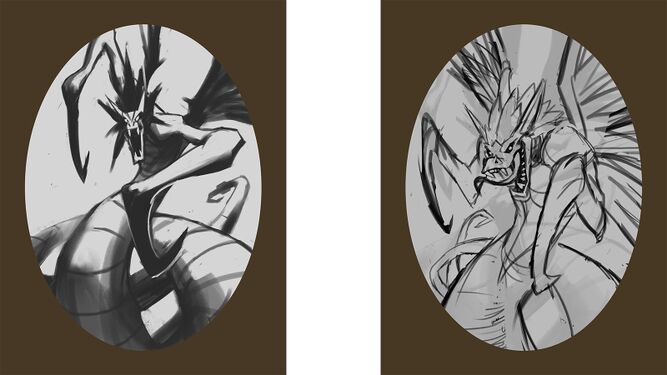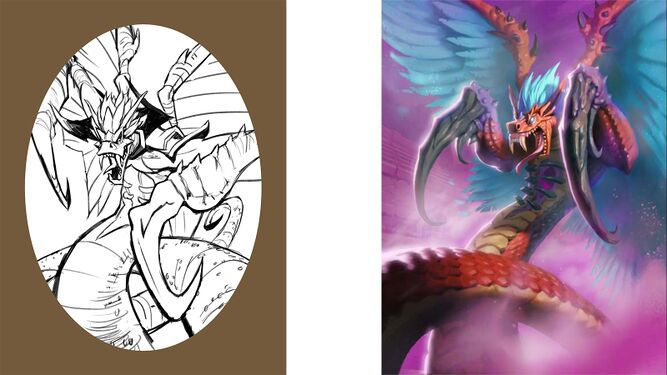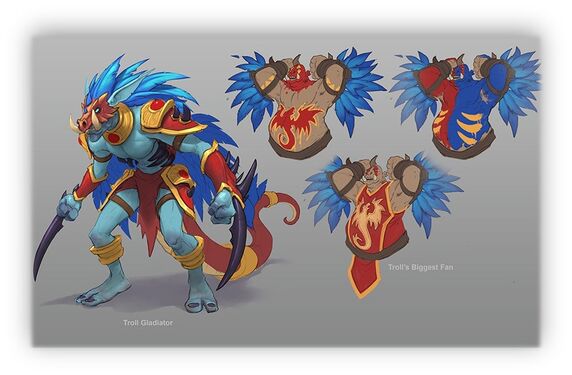Hakkar, the Soulflayer
Hakkar, the Soulflayer is a legendary neutral minion card, from the Rastakhan's Rumble set.
How to get
| Type | Source | Quality | Count |
|---|---|---|---|
| Card packs | The Regular version can be opened from any of these packs: | Regular | 1 (random) |
| Card packs | The Golden version can be opened from any of these packs: | Golden | 1 (random) |
| Crafting | Craft a Regular copy for 1600 | Regular | 1 |
| Crafting | Craft a Golden copy for 3200 | Golden | 1 |
Related cards
Notes
To edit these notes, go to Template:Hakkar, the Soulflayer notes.
- Corrupted Blood's shuffle effect occurs after the card draw. This means that drawing a Corrupted Blood and activating its effect occurs in the following sequence:
- The player draws a copy of Corrupted Blood.
- Their hero takes 3 damage.
- They draw another card. If the next drawn card is
- a copy of Corrupted Blood, go to step 1.
- a Casts When Drawn card (i.e., a non-terminal card) other than Corrupted Blood, then execute its effect and continue with the current step 3.
- a terminal card (any card that does not have the Casts When Drawn keyword) or if they take Fatigue damage due to an empty deck, go to step 4.
- Two new copies of Corrupted Blood are shuffled into their deck for each copy of Corrupted Blood that has been drawn in the current sequence.[1]
- If the original draw effect stated to draw multiple cards (like
 Arcane Intellect or
Arcane Intellect or  Octosari), continue drawing cards. If another copy of Corrupted Blood is drawn, go back to 1.
Octosari), continue drawing cards. If another copy of Corrupted Blood is drawn, go back to 1.
- If the player only has copies of Corrupted Blood and no other cards in their deck, they will draw all of their Corrupted Bloods in sequence, take 3 damage from each, draw once from their empty deck and take Fatigue damage, and then shuffle new Corrupted Blood copies into their deck.[2]
- Since Corrupted Blood is a 1-mana spell, it can be destroyed by
 Skulking Geist[1][3] or replaced by
Skulking Geist[1][3] or replaced by  Prince Liam.[1]
Prince Liam.[1] - If a player’s hand is full when they attempt to draw a Corrupted Blood, the Corrupted Blood will be destroyed and have its effect nullified.
Sounds
- Play
- ▶️
VO_TRL_541_Male_Creature_Play_01.wavPride heralds the end of the world! - ▶️
Hakkar_Play_Stinger.wav<music stinger>
- Attack
- ▶️
VO_TRL_541_Male_Creature_Attack_01.wavFace your doom!
- Death
- ▶️
VO_TRL_541_Male_Creature_Death_01.wav<death sound>
History
Design
According to lead mission designer Dave Kosak, Hakkar's inclusion in Rastakhan's Rumble was an obvious choice:
- "If we were going to do a set that really explored trolls and troll culture, very clearly we had to talk about loa. It's just such an important part of who trolls are, and it's also just a really fun dynamic idea to play with. So you can see with our cards, our champions and our loa and their spirit cards that are associated with them, are a big part of the set. But if we're gonna talk about loa, then probably the one that players from World of Warcraft know the most would be Hakkar.
- "Hakkar led to one of the most studied events in World of Warcraft history when the Corrupted Blood spilled out of the raid encounter and infected the servers. The Centers for Disease Control, I believe, studied this event as a simulation of an actual outbreak, which is amazing. So obviously we wanted to have that. Hakkar is just sort of one of the big bads in troll lore. Even the threat that someone would summon or bring back Hakkar was so scary that trolls from around the world arrived to put a stop to it.
- "That was very exciting for us. So we knew it had to have a prominent place in our set, and that's one of the reasons why we made it one of our neutral legendaries, so everybody can have a little bit of fun with the Soulflayer."[1]
When it came to implementing Hakkar in Hearthstone, the developers tried several different versions. According to game designer Peter Whalen, Hakkar was one of the cards that went through the largest amount of
different iterations during the development of the expansion,[4][5] probably the second most after ![]() Zul'jin.[5]
Zul'jin.[5]
The first iteration had Hakkar corrupt a minion which would die at the end of the controlling player's turn and spread the corruption effect to all other minions, which would in turn die as well and keep spreading the plague. However, this quickly became exploitable since as long as one player could summon a minion every turn, neither player could progress the game.[1] Another version corrupted all other minions, causing them to die at the end of turn without the spreading effect. Another version caused the player to take control of any enemy minions that Hakkar killed. Yet another iteration permanently disabled the opponent's Hero Power for the rest of the game, but this effect was found to be overly punishing for the opponent.[5] The developers subsequently tried various ideas based on some of Hakkar's other abilities from his World of Warcraft boss encounter. However, they found that when they asked people what they thought of when they thought of Hakkar, the answer was always Corrupted Blood, and so the developers especially wanted to focus on that aspect of the character.[1]
One early iteration of Hakkar only shuffled a Corrupted Blood into the opponent's deck,[1] with one particular design having him as 10-mana 8/8 minion,[5] but the team soon realized that players were just using Hakkar to beat control decks since Corrupted Blood would continually eat away at the opponent's Armor. Around the third or fourth iteration of Hakkar, the team came up with the idea of shuffling Corrupted Blood into both players' decks, which both shows off the story of Corrupted Blood really well and provides interesting gameplay as it challenges the player to figure out how to out-survive their opponent.[1]
At first, the team thought it would be interesting if Corrupted Blood dealt its damage to the player, shuffled its copies into their deck, and then let the player draw again. However, if this led to the player reaching Fatigue, it would essentially act as an instant kill (since the player would just draw copies of Corrupted Blood over and over), and the developers found it to be less interesting than if Corrupted Blood shuffled into the deck after the player drew again. This way, a player with only Corrupted Blood in their deck will take damage from the Corrupted Blood, then take damage from Fatigue, and only then shuffle new Corrupted Blood copies into their deck. As a result, the player will still die within two or three turns if they're out of cards and only have Corrupted Blood in their deck, but it still gives them a last-minute chance to try to close the game out before they die.[1]
Elaborating on why the team likes Hakkar, Dave Kosak explains:
- "Something we really like about it is, first of all summoning the card has that kiss/curse element. You're summoning something terrible and it's also got a consequence you've got to deal with. But also, in the same way that players intentionally spread the Corrupted Blood to cities just to cause havoc [in Warcraft], it's that idea of you look at this card and as a player, you think to yourself, how can I take advantage of this?
- "Am I going to play a rogue and destroy my own deck so I get rid of it? Am I going to destroy my opponent's deck and then shuffle in the Corrupted Blood so they're dead instantly? You begin immediately mapping out degenerate ways you can take advantage of this mechanic, which we think is really fun."[1]
Initial designer Liv Breeden further points out that Hakkar also creates interesting gameplay if he appears in a game through random effects, as he can force both players to suddenly have to deal with having Corrupted Blood in their deck.[1]
Hakkar's card art also went through several iterations. With Hakkar being a "uniquely weird" serpentine creature with wings and blades in place of hands, the team wanted to find the best way of displaying all of Hakkar's various elements and show off as much of the loa as possible. Dave Kosak emphasizes that most of the iterations primarily consisted in finding the right pose and finding a way to have the card art look menacing while still containing all of the various visual elements that call attention to the Soulflayer.[1]
Lore
- Hakkar the Soulflayer, the Blood God, is a malevolent and destructive loa notably worshipped by the Gurubashi trolls, and known in the troll pantheon as the Loa of Blood. He at one point controlled the Gurubashi Empire's fallen capital of Zul'Gurub.
- Hakkar the Soulflayer was the final boss of the Zul'Gurub raid until it was removed with patch 4.0.3a and Zul'Gurub was turned into an ordinary subzone of Northern Stranglethorn. Though the world believed Hakkar to be dead, there were rumors that the god might return one day. These ultimately proved true, when the troll Jin'do brought back his spirit in order to drain the blood god's powers into himself.
- Hakkar's blood is very potent. A small amount of his blood obtained by Jammal'an the Prophet was injected into green dragons to use their bodies to produce the massive quantities of blood necessary to summon Hakkar into the world through a dark ritual that was thwarted by a group of heroic Alliance adventurers assaulting the temple. Farmed like livestock, the evil that grew within them was then harvested. Hakkar's blood had devastating effects on the dragons. These former jailors of the Atal'ai were corrupted by its presence in their bodies and became creatures of
 Nightmare. Even Eranikus, one of the greatest green dragons, infused with the largest quantities of blood, became twisted beyond imagination.
Nightmare. Even Eranikus, one of the greatest green dragons, infused with the largest quantities of blood, became twisted beyond imagination.
In the story of Rastakhan's Rumble, Hakkar shows up to "crash the party" even though he's "not invited".[6] The Soulflayer's use of Corrupted Blood in Hearthstone is in reference to the Corrupted Blood incident that occurred when players first faced Hakkar as a raid boss in the original Zul'Gurub instance in Classic World of Warcraft. During the boss encounter, Hakkar would afflict players with a debuff called "Corrupted Blood", which would cause them to take damage every few seconds and which could spread to other players who were simply standing in close proximity to an infected player. The disease was intended to remain confined to Zul'Gurub, but a technical oversight allowed hunter and warlock players to spread the debuff to the outside world by intentionally allowing their pet or demon minion to become infected, dismissing the pet (thus pausing the duration of the debuff), and then resummoning it outside Zul'Gurub, particularly in capital cities where many players congregated. The debuff began to quickly spread from player to player, instantly killing low-level players and making popular cities virtually uninhabitable. The plague persisted until Blizzard patched the debuff so that it could no longer exist outside of Zul'Gurub. However, player response to the event was oddly positive, leading to Corrupted Blood becoming one of the most well-known events in World of Warcraft history, and university researchers studied the event as an example of how real-world pandemics might spread.
Trivia
- The very first gladiator team concepted during the development of Rastakhan's Rumble was a team known as "Hakkar's Soulflayers", but the developers eventually decided not to put Hakkar with a team since he is so evil that he would likely just eat all of his gladiators. However, while the team was scrapped, the concept sketches done for Hakkar's Soulflayers helped inform the visual designs of the other loa teams in the expansion.[6]
Gallery
Patch changes
 Patch 22.2.0.130051 (2022-01-25):
Patch 22.2.0.130051 (2022-01-25):
- Fixed a bug where the game would instantly end in a draw if either player's deck reached 60 Bloods without dying. Games will now continue to go on with players taking 180 damage per turn from a full deck of Bloods until someone dies.
 Patch 13.2.0.28855 (2019-02-05):
Patch 13.2.0.28855 (2019-02-05):
- Fixed a bug where
 Corrupted Blood was improved by Spell Damage from minions on the player's board.
Corrupted Blood was improved by Spell Damage from minions on the player's board.
- Fixed a bug where
 Patch 13.0.0.27845 (2018-11-29):
Patch 13.0.0.27845 (2018-11-29):
- Added.
External links
References[edit | edit source]
- ↑ 1.00 1.01 1.02 1.03 1.04 1.05 1.06 1.07 1.08 1.09 1.10 1.11 Heather Newman (2018-11-20). Exclusive: Hakkar Revealed As The Newest Legendary Card In 'Hearthstone'. Forbes. Retrieved on 2018-11-20.
- ↑ Peter Whalen on Twitter (X). (2018-11-20).
- ↑ Peter Whalen on Twitter (X). (2018-11-20).
- ↑ Peter Whalen on Twitter (X). (2018-11-23).
- ↑ 5.0 5.1 5.2 5.3 Cam Shea (2019-02-04). Hearthstone: Peter Whalen and Dean Ayala on Designing Key Rastakhan Cards. IGN. Retrieved on 2019-02-06.
- ↑ 6.0 6.1 BlizzCon 2018: Hearthstone: What's Next. (2018-11-02). Retrieved on 2018-11-20.

